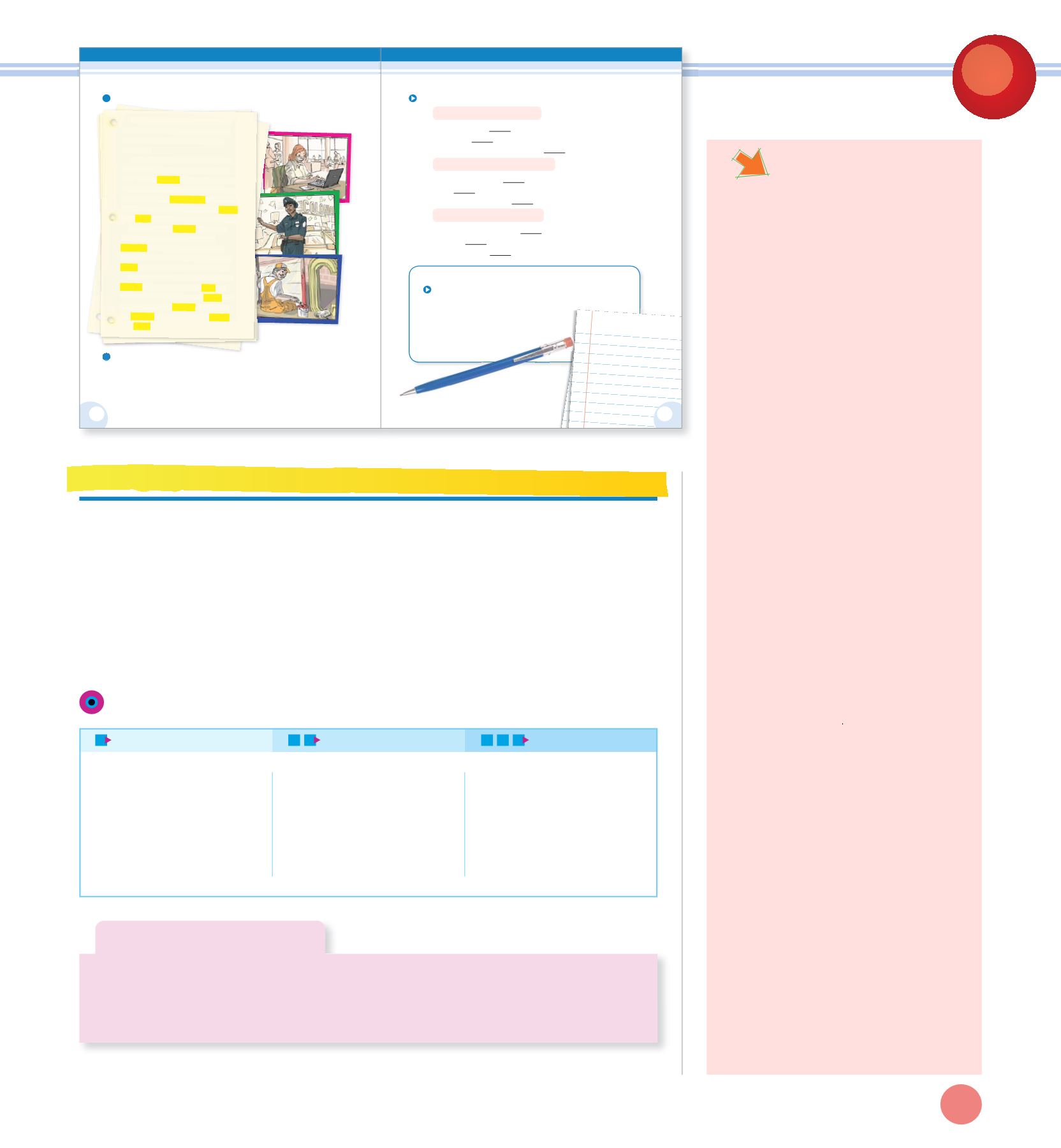

Focusing
Student Book page 129: Read the directions with students. Ask them what the
word choices have in common. Elicit that the words share the same root but have
different endings. Read the first item. Then, read the answer choices. Say Works
is
an action word, a
worker
is a person who works, and
working
is a thing someone
has to do. This sentence needs an action word.
Ask students to identify the action
word. Continue reading each item, asking students for the answer choice that best
fits the sentence. Have students record their answers in their notebooks.
My Community
Unit 4
129
$
I want everyone to know that saving
h
t e Colonial Theater was a community
effort. Many people helped to make
it happen.
Both my parents helped. My mother
was by my side all the time. My father
didn
’
on weekends to help
t mind working
people know how important it was to save
the theater. As a police offi
r, he knows
ce
what it means to be a community worker
f
th
l
f Ph
i
ille.
or
e peop e o
oen xv
who works
The newspaper reporter who wrote
about me also helped. She knows
is important for the people
reporting
of Phoenixville. Everyone who read her
wants to help save the theater.
report
Then, there is Pablo. He is one of the
who volunteered to paint the
painters
Colonial Theater when it was r
t. He
ebuil
spent many hours painting the walls of
the building. Pablo works for a builder
who builds homes all over Pennsylvania.
$
*&) 43.&
’
8 1*99*7 &'4:9 9-* 7*':.1).3, 4+ 9-* 9-*&9*7
38<*7 9-* 6:*89.438 .3 (4251*9* 8*39*3(*8
#-&9 )4*8 & 541.(* 4+A(*7 )4
#4:1) 9-* 5&.39*7 <470 43 9-* 9-*&9*7 '*+47* 47 &+9*7
9-* ':.1)*7 #->
$
r
y
Whe e &do &
ou &work?
hat
o yo
&l
W
&d &
u ike
bo t &
or
g
er
&a u w kin &h e?
%#
-448* 9-* (477*(9 <47) +742 *&(- ,74:5 94 (4251*9* 9-* 8*39*3(*8
<4708 <470*7 <470.3,
43.&
’
8 +&9-*7
&8 & 541.(* 4+A(*7
47 -.2 +47 9-* (422:3.9> .8 .25479&39
541.(* 4+A(*7 .8 & (422:3.9>
':.1)8
':.1)*7
':.1).3,
&'14 <4708 +47 &
*
-42*8 .3 *338>1;&3.&
&'14 <470*) 43 9-*
9-&9 <&8 8&;*)
7*5479 7*5479*7 7*5479.3,
-.8 <42&3 <4708 &8 &
+47 & 3*<85&5*7
-* .8
9-* 8947> 4+ -4< 9-* 9-*&9*7 <&8 8&;*)
43.& <749* &
&'4:9 9-* -.8947> 4+ 9-* ':.1).3,
!! (
#7.9* 6:*89.438 +47 & (422:3.9> <470*7
-.30 4+ & (422:3.9> <470*7 <-48* <470 .39*7*898 >4:
3;.9* 9-.8 5*7843 94 (42* 94 >4:7 (1&88
94 9&10 &'4:9 9-* <470 -* 47 8-* )4*8
9&79 >4:7 6:*89.438 <.9-
6:*89.43 <47)8
Targeting Proficiency Levels
Read each sentence aloud,
replacing the blank with
each answer choice in
that group. Help students
choose the best word for
each sentence.
Have students work
independently to
determine the best
answer choice for each
sentence.
Have students work in
pairs to determine the
best answer choice for
each sentence.
Beginning
Intermediate
Advanced
Meeting Individual Needs
You may assist students who exhibit difficulty selecting the correct form of each word by
creating a three-column chart that shows the root word, the ending added to that root
word, and what the word ending means.
Direct Instruction
Suffixes
Suffixes
are groups of letters that are
added to the end of a word. There
are two types of suffixes: derivational
suffixes and inflectional suffixes.
A derivational suffix creates a new
word with a different meaning from
the original word.
Examples of derivational suffixes
include:
Q
The suffix
-ship
means “state
or quality of,” as in the word
friendship
.
Q
The suffixes
-like
and
-ly
mean
“resembling,” as in the words
sisterly
and
childlike
.
Q
The suffix
-est
means “most,” as
in
closest
or
quickest
.
Q
The suffix
–ment
means “action
or process,” as in
government
or
development
.
Q
The suffix
–ful
means “full of,” as
in
careful
or
thoughtful
.
Q
The suffixes
-able
and
-ible
mean “can
be,” as in
comfortable
or
combustible
.
Q
The suffix
-er
means “more,” as in
lighter
or
softer
.
Q
The suffixes
-ation
and
-sion
mean “state or quality of,” as in
starvation
or
tension
.
Q
The suffix
-arian
means “one
who,” as in
librarian
.
Q
The suffix
-wise
means “manner
or direction,” as in
clockwise
or
lengthwise
.
Q
The suffixes
-th
and
-eth
mean
“numbers,” as in
fifth
or
fiftieth
.
Have students brainstorm a list of
words with these suffixes. Write them
on the board or on chart paper. Ask
students to circle the suffix in each
word. Then ask for volunteers to
explain the relationship between that
word and the original word.
WRITING STRATEGIES
51


















